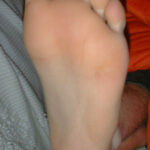If you have muscle twitching and have googled twitching muscles, you’ve most likely stumbled upon some links for the deadly disease ALS. You now might think you have ALS, since muscle twitching is a symptom of incurable ALS. But if you read more about ALS, you’ll realize that muscle twitching comes after muscle weakness. However, you may now suddenly be experiencing what you believe to be weakness in your muscles.
In ALS, one of the first muscles to go is often the muscles that control foot movement, particularly up and down movement. In ALS clinical muscle weakness, the result is what’s known as a foot drop. The muscles that control the joint action of dorsiflexion no longer work, and thus, the foot drops. A person suffering from fear he or she has ALS might start thinking he has this foot drop. If he stumbles upon bunched-up carpet, right away he’ll think foot drop.
He or she will perform endless strength tests for these muscles to check for the drop, and no matter how well he does these muscle strength tests, he’ll never be assured he doesn’t have foot drop. UNLESS, perhaps, he knows the right kinds of muscle strength tests to perform.
A person with clinical foot drop can’t do these.
If you’re suffering from foot drop obsession, there are exercises that if you CAN perform, you can eliminate the possibility of ALS. A person with clinical (pathological) foot drop will find it absolutely impossible to do the following:
Using the foot pedal while driving. Yes, as simple as this is, a person with ALS foot drop will not be able to do this. This action requires continuous dorsiflexion, the very muscles that, when healthy, prevent foot drop. Though these muscles don’t work hard to operate the car’s pedal, the continuous use of these muscles are significant. This test applies only if the person already normally uses the foot on the pedal (depending on driving habits).
Stair jumping. Stand at bottom of staircase. With both feet at the same time, jump to next step. Land with both feet at the same time. Repeat to the next step. Go all the way to the top. No matter how out of breath or awkward you feel, if you can simply do this at all, then eliminate foot drop. This isn’t a fitness test. It’s a “Can I even do this?” test.
If you’re clumsy (and you WILL be, due to anxiety of passing this test), this doesn’t matter, because MOST people cannot do this without a little (or even a lot) of clumsiness. I’m a fitness trainer and only a few of my clients were able to smoothly hop up a flight of stairs: boing boing boing boing boing. Other clients were sloppy and uncoordinated. A person with ALS foot drop will NOT be able to do this at all.
Standing on one foot. Muscles required to do this are the same that prevent foot drop. If a person can stand on one foot, rule out ALS immediately. If you stand on one foot, you’ll feel these muscles at work. Expect to lose balance quickly the first several attempts, because anxiety will loom. But keep at it and sooner or later you’ll find yourself balancing nicely. A person with ALS foot drop will NOT be able to balance, no matter how many times they attempt it.
Stair running. Run up the stairs as fast as possible, then down. If the muscles that control dorsiflexion are dead, you won’t be able to do this…at all.
If you can perform all of these routines (regardless of clumsiness or number of attempts required), then you’re free of ALS, have healthy muscles, and the foot drop is all in your imagination.


